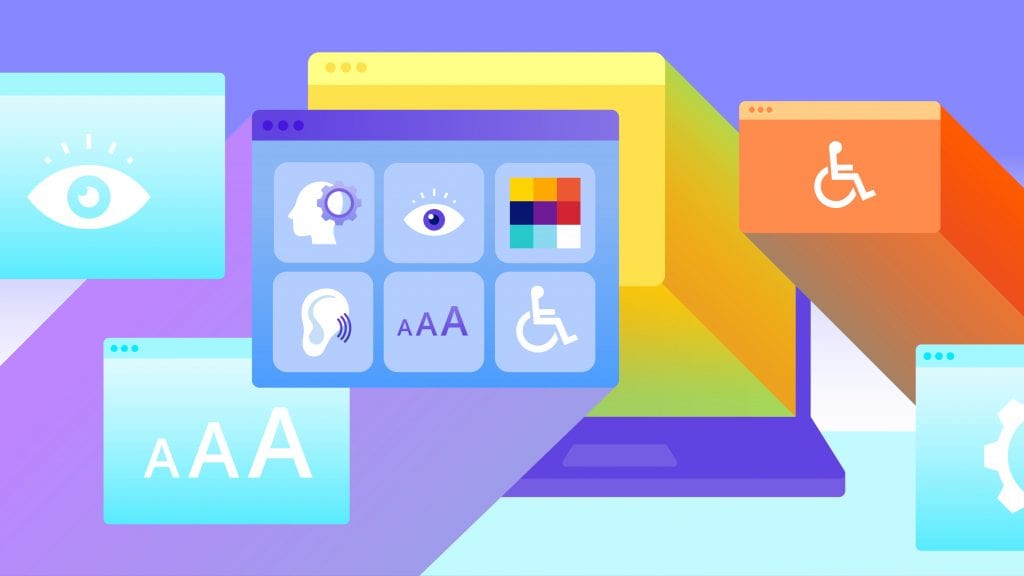Key Learnings from UsableNet’s 2020 ADA Digital Accessibility Lawsuits Report
ADA-related cases in 2020 increased 23%. Learn other key findings from Usablenet’s Digital Accessibility Lawsuits Report in this summary.

Businesses can learn more about ADA compliance standards through UsableNet’s year-end report on 2020 digital accessibility lawsuits.
Title III of the Americans with Disabilities Act (ADA) has evolved from demanding accommodations at physical locations to requiring them online.
Yet, many companies fail to make their online information, products, and services fully available to people with disabilities. The internet has just as many, if not more, hurdles for disabled people as restaurants without menus in Braille or subway stations without elevators.
When a company’s online presence lacks digital accessibility, lawsuits against companies based on their failure to comply with Title III are a frequent result. Let’s take a look at what UsableNet found about accessibility lawsuits in 2020.
How COVID-19 Impacted Accessibility Lawsuit Filings
COVID-19 lockdowns reduced filings, with the fewest cases filed in April 2020. But cases increased from there. By December 2020, the case filing rate had increased by 50% compared to the pre-pandemic filing rate.
Where Are Plaintiffs Filing and Why?
A plaintiff—the person or business that brings the lawsuit—can file in any state where the defendant does business. They don’t have to file where the company is headquartered.
Despite the possibilities, plaintiffs filed over 90% of 2020 digital accessibility lawsuits in…
- New York: 1,756 cases
- California: 989 cases
- Florida: 542 cases
Part of the reason for this may be the popularity of certain plaintiff law firms. In 2020, the same 10 plaintiffs’ firms brought 70% of all cases. A much deeper pool of law firms represented the defendants.
Other possibilities are that both New York and California:
- Allow plaintiffs to sue in either federal or state court,
- Are known to favor plaintiffs, and
- Allow for monetary damages.
Who Are Plaintiffs Targeting?
Digital accessibility lawsuits aren’t spread evenly across industries. Most 2020 lawsuits were filed against retailers, making up 77.55% of cases. The next most common defendant was in foodservice with 7.77% of cases.
Other industries facing lawsuits for digital accessibility violations were in…
- Education
- Entertainment and Leisure
- Banking and Finance
- Insurance
- Healthcare
- Travel and Hospitality
There are a few reasons why plaintiffs sue retailers more. Retailers’ websites and apps tend to be more complicated, and they change their online content often. Despite these factors, their web development teams may have limited resources to address ADA compliance thoroughly.
Second-Time Defendants
The businesses aren’t all first-time defendants. More than 20% of lawsuits involved plaintiffs filing against a company that someone had sued at least once in the previous two years. In all, plaintiffs had sued 652 companies multiple times.
Multiple claims against the same company are partly due to the popularity of these “Surf-by” lawsuits. Some organizations don’t make changes fast enough or are willing to ignore ongoing issues. Other times, businesses develop apps or new content yet fail to address ADA compliance for those.
Plaintiffs, who often rely on “testers,” don’t worry about whether a company has time to improve accessibility across all digital assets. The sole purpose of testers is to check websites and apps for ADA accessibility violations for potential legal action.
Another factor is that repeat defendants tend to be large companies, bringing in $100 million or more in revenue annually. Companies like this want to avoid high litigation costs, so going to court may be more expensive than fixing the violation. And it is these circumstances that drive businesses toward quick settlements.
The Basis for the Accessibility Lawsuits
Plaintiffs based most of their digital accessibility lawsuits on issues with desktop websites (3,235 claims). The second most common reason was problems with mobile apps (296 claims). There were 16 claims combining website and mobile app issues, and three claims involving mobile websites.
Mobile apps will continue to draw more scrutiny. In the Domino’s pizza accessibility lawsuit in 2019, the court ruled the ADA applied to mobile apps, too. The U.S. Department of Justice also has said ADA compliance applies to apps.
Video accessibility has become a bigger factor in recent years. There were 150 lawsuits based on video accessibility, including a lack of closed captions and audio descriptions. These are relatively easy to document to build a strong case.
There Are No Shortcuts to ADA Compliance
A finding that should interest businesses is that widgets and overlays aren’t a solution. Plaintiffs filed an average of one lawsuit per day—more than 200—against a company using an overlay or widget meant to help with digital accessibility.
A widget or overlay is a quick fix to a website. It doesn’t address the underlying code of the website or app. Ultimately, it doesn’t fix the accessibility issues and might add to a disabled user’s challenges. Accessibility is essential – it draws in your audience with greater engagement and allows everyone the ability to view, watch and gain value from your videos.
A Tentative Accessibility Standard
Businesses struggle with the lack of concrete standards regarding digital accessibility. However, Web Content Accessibility Guidelines (WCAG) 2.1 is a popular benchmark that businesses can access.
While the law doesn’t require organizations to adhere to WCAG, accessibility and legal experts recommend it. Businesses on the fence about it should note legal claims in 2020 more frequently cited WCAG 2.1. WCAG-based standards also were recently considered by Congress.
Quick Summary of UsableNet’s 2020 ADA Digital Accessibility Lawsuits Report
The number of digital accessibility lawsuits has increased over the past three years, reaching 3,550 cases in 2020. The most common defendant was in retail, and plaintiffs based most claims on desktop websites’ accessibility violations. Legal claims involving mobile apps, video accessibility, and citing WCAG are growing.
Subscribe to The Rev Blog
Sign up to get Rev content delivered straight to your inbox.



